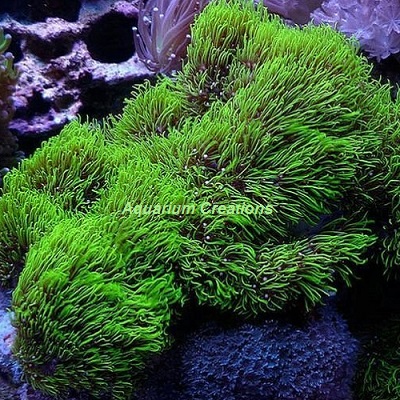Metallic Green Star Polyps (Pachyclavularia sp.) are as bright as they come. Large colonies are similar in appearance to a phosphorescent lawn. If you’re looking for a great beginner coral, that's easy to maintain, there is no better. When closed metallic green star polyps body color ranges from a bright purple to a dark red. When their bright green polyps come out and open up they will cover the mat and many times you won't see the body color at all. Beautiful polyps will sway nicely with the water flow. Accurately described as an encrusting coral, metallic green star polyps grow over adjacent rock work and sometimes can even go up the glass of an established reef aquarium. Care should be taken when placing this coral into your aquarium. If given the right placement in good water quality, this coral will often grow quickly. Be sure to leave a minimum of six inches between corals to allow for growth.
Aggressiveness
They are a peaceful coral with the capability of being able to retract or deflate their polyps in response to a bothersome predator. They will not bother nearby corals since they do not have sweeper tentacles.
Waterflow
We recommend a moderate to high level of waterflow.
Lighting
Metallic Green Star Polyps require a moderate to high lighting level,(PAR 130-250), to maintain their color. T5's, Metal Halides, or LED's can all grow Daisy Polyps when the proper PAR levels are provided. We recommend a 14-20K color spectrum for best colouration of the coral.
Placement
Metallic Green Star Polyps Coral may be placed anywhere which provides the required water flow and lighting level.
Diet and Feeding
In captivity, the symbiotic algae zooxanthellae hosted within their bodies provide the majority of their nutritional requirements through photosynthesis. We also recommend weekly feeding's of micro-plankton or other reef foods designed for filter feeding invertebrates. Good choices include Marine Snow, Artemia nauplii, and rotifer's. If your lighting is not as strong as desired, the feeding's will be more important since they will not be developing as much zooxanthellae on their own. Increase feeding's to twice a week in that case. For continued good health, we recommend the addition of iodine and other trace elements to the water. To help provide food for all your corals we strongly suggest putting up a refugium for your reef system. Make sure it has at least a 4" sand bed. It really helps your coral do well since it naturally provides correct food for your corals.
|



